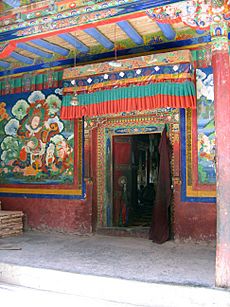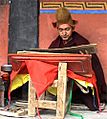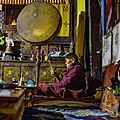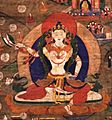Tibetan Buddhism facts for kids
|
Basic terms |
|
|
People |
|
|
Schools |
|
|
Practices |
|
|
study Dharma |
|
Tibetan Buddhism is a special kind of Buddhism that comes from Tibet. It is also known as Lamaism. It's a big part of Mahayana Buddhism, which is one of the main types of Buddhism still practiced today. The other two main types are Han Buddhism (from China) and Theravada Buddhism. You'll find Tibetan Buddhism most commonly practiced in places near the Himalayas, in Central Asia, and in Siberia.
Tibetan Buddhism includes all the different Buddhist teachings. Followers practice moral rules, work towards helping everyone find freedom, and use special methods from the secret mantra teachings called Vajrayana.
Contents
A Look at History
How Buddhism Came to Tibet
Buddhism first arrived in Tibet in the 7th century. This happened when Songtsen Gampo, a Tibetan king, married two princesses who were Buddhists. One was Princess Wencheng from the Tang Dynasty in China, and the other was Princess Bhrikuti from Nepal. They helped bring Buddhist ideas to Tibet.
Over time, Buddhism mixed with the local Bön religions of the Zhangzhung people. This blend created the unique form of Buddhism we now call Tibetan Buddhism. Tibetans also started translating important Buddhist texts from Sanskrit and Chinese into their own language. They also began writing their own religious books.
In the 8th century, an Indian teacher named Padmasambhava brought even more Buddhist teachings to Tibet when Trisong Detsen was king. Padmasambhava also wrote many important texts.
Spreading Across Asia
By the 11th century, Tibetan Buddhism had a strong influence on people in Central Asia, Mongolia, and Manchuria. It became very popular during the time of the Mongol Yuan dynasty and the Manchu Qing dynasty in China.
Main Schools of Tibetan Buddhism
Tibetan Buddhism has four main groups or "schools." Two of these schools focus more on practicing the teachings, while the other two focus more on studying the philosophy and ideas.
- Nyingma: This school is called "The Ancient Ones." It is the oldest and was started by Padmasambhava. It focuses on practice.
- Kagyu: This school is known as the "Oral Lineage." It has a major branch called Dagpo Kagyu and a smaller one called Shangpa Kagyu. This school also focuses on practice.
- Sakya: This school is named "Grey Earth." Its leader is the Sakya Trizin. It was founded by Khon Konchog Gyalpo. This school focuses on scholarly study.
- Gelug: This school is called the "Way of Virtue" and is also known as the "Yellow Hats." Its spiritual leader is the Ganden Tripa, and its former political leader was the Dalai Lama. The Dalai Lamas ruled Tibet from the mid-17th to mid-20th centuries. This school also focuses on scholarly study.
Important Teachings
Some of the key teachings in Tibetan Buddhism include Mahamudra, the Six Yogas of Naropa, and Dzogchen. These are special practices and ideas that followers learn and use.
Language of Practice
Classical Tibetan is the main language used for religious texts and practices in Tibetan Buddhism. However, many important texts have also been translated into Mongolian, Manchu, and Chinese.
Monasteries: Places of Worship
Monasticism, where monks and nuns live together in special communities, was very important for Buddhism in Tibet. There used to be over 6,000 monasteries in Tibet. Sadly, almost all of them were destroyed by Chinese Red Guards during the Cultural Revolution. Today, most of the major monasteries have been partly rebuilt, but many others are still in ruins.
Tibetan Buddhism Today
Today, Tibetan Buddhism has spread far beyond Tibet. You can find it practiced in the Tibetan Plateau, Nepal, Bhutan, Mongolia, Kalmykia, Siberia, the Russian Far East, northeast China, and Arunachal Pradesh in India. It is the official state religion of Bhutan.
Large groups of Tibetan Buddhists also live in the Indian regions of Sikkim, Ladakh, Himachal Pradesh, and West Bengal. There are also communities in South India.
Tibetan Buddhism has also grown in popularity in Western countries and around the world. Some famous people who practice it include Brandon Boyd, Richard Gere, Adam Yauch, Jet Li, Jackie Chan, Sharon Stone, Allen Ginsberg, Philip Glass, Mike Barson, and Steven Seagal.
Related pages
- Sometimes called "Hinayana" or Fundamental Vehicle
Images for kids
-
Colorized photo of Gandantegchinlen Monastery in 1913, Ulaanbaatar, Mongolia
-
The 14th Dalai Lama meeting with U.S. President Barack Obama in 2016. The Dalai Lama is a well-known figure of Tibetan Buddhism around the world.
-
Kagyu-Dzong Buddhist center in Paris.
-
A statue of one of the most important Buddhist philosophers for Tibetan Buddhist thought, Nagarjuna, at Samye Ling (Scotland).
-
The 14th Dalai Lama praying in the pavilion, closing the Kālacakra mandala and offering flowers, during a Kālacakra initiation in Washington, D.C., 2011.
-
The reading of the text - the 'lung' - during an empowerment for Chenrezig.
-
An elderly Tibetan woman with a prayer wheel inscribed with mantras
-
The Potala Palace in Lhasa, chief residence and political center of the Dalai Lamas.
See also
 In Spanish: Budismo tibetano para niños
In Spanish: Budismo tibetano para niños























